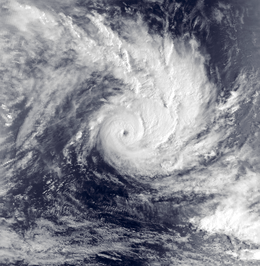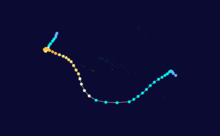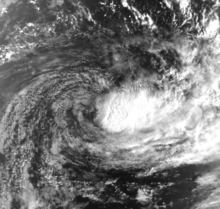Cyclone Wasa–Arthur
| Category 4 severe tropical cyclone (Aus scale) | |
|---|---|
| Category 3 (Saffir–Simpson scale) | |
 Severe Tropical Cyclone Wasa while it was near its peak intensity | |
| Formed | December 3, 1991 |
| Dissipated | December 18, 1991 |
| Highest winds |
10-minute sustained: 165 km/h (105 mph) 1-minute sustained: 195 km/h (120 mph) |
| Lowest pressure | 940 hPa (mbar); 27.76 inHg |
| Fatalities | 2 |
| Damage | $60 million (1992 USD) |
| Areas affected | French Polynesia |
| Part of the 1991–92 South Pacific cyclone season | |
Severe Tropical Cyclone Wasa–Arthur was the first major tropical cyclone to affect French Polynesia and Tahiti since the 1982–83 season. The system was first noted on December 3, 1991 as a shallow tropical depression that was embedded within the monsoon trough, to the north of the Cook Island: Rarotonga. Over the next couple of days the system gradually developed further, before it was classified as a tropical cyclone and named Wasa during December 5. The system gradually strengthened further and acquired hurricane-force winds on December 6, as it performed a small clockwise loop. After completing the loop, Wasa moved southwards before it peaked in intensity during December 8, with sustained wind speeds of 165 km/h (105 mph). Over the next few days the system started to weaken as it passed through the French Polynesian Society Islands, and became the first major tropical cyclone to affect French Polynesia since 1983.
During December 12, Wasa passed through the French Polynesian Austral Islands and passed directly over Tubuai, before it degenerated into a tropical depression later that day. However, gale force winds remained associated with the depression, before the system turned towards the east-northeast and entered into warmer waters near the Tuamotu Islands. During December 14, Wasa regenerated into a tropical depression and was renamed Arthur for various reasons. During that day the system gradually intensified before it reached its secondary peak intensity with sustained wind speeds of 95 km/h (60 mph). During December 15, the system maintained its peak intensity, as it moved through the uninhabited Acteon Group of islands, before during the next day it started to gradually weaken. Arthur degenerated into a shallow depression during December 17, before it was last noted during the next day as it dissipated to the north of the Pitcairn islands.
Tourists on the island of Bora Bora were evacuated to a local church, after Wasa–Arthur had swept high seas into tourist bungalows. Overall the system caused an estimated US$60 million in damage within French Polynesia, with the majority of the damage done between December 9 – 12. The system destroyed or damaged several homes, a variety of crops and damaged several public buildings, hotels, roads and power installations, with the worst affected islands being Bora Bora and Tubuai. On Rurutu island, Moerai harbour was destroyed by a cyclonic swell generated by the system, while the local school and police station were destroyed by high waves. Two people were killed after torrential rainfall from the system caused a mudslide on the island of Moorea, during a night of torrential rain the day after Wasa had made its closest approach to the island. The French Government incurred costs of about FF68 million including FF53 million for the efforts of the French Military. The French Polynesian Government subsequently borrowed FF55 million and built up a fund from local banks of about FF1.5 billion, to help with the reconstruction. The name Wasa was later retired, from the list of tropical cyclone names by the World Meteorological Organization.
Meteorological history

On December 3, the Fiji Meteorological Service started to monitor a shallow tropical depression, that had developed within a monsoon trough about 1,250 km (775 mi) to the north of Rarotonga, in the Southern Cook Islands.[1] Over the next two days, the system gradually developed further as it moved towards the southwest, before during December 5, the Naval Western Oceanography Center (NWOC) started to monitor the depression and designated it as Tropical Cyclone 07P after it had become equivalent to a tropical storm.[1][2] Later that day, TCWC Nadi reported that the system had developed into a category one tropical cyclone on the Australian tropical cyclone intensity scale and named it Wasa, while it was located about 250 km (160 mi) to the south-west of the Cook Islands Penhryn.[1][3] During December 6, Wasa developed hurricane force winds in an area of low vertical wind shear as it performed a small clockwise loop before it started to move towards the southeast during December 8, as an equatorial westerly wind burst affected the system.[1][4] Early on December 8, the NWOC reported that Wasa had peaked in intensity with 1-minute sustained wind speeds of 195 km/h (120 mph), which made it equivalent to a category 3 hurricane on the Saffir-Simpson hurricane wind scale.[5] TCWC Nadi subsequently reported during the next day, that Wasa had become a Category 4 Severe tropical cyclone, as it reached its peak intensity with 10-minute sustained winds of 165 km/h (105 mph).[3]
Over the next few days the system started to weaken as it passed through the French Polynesian Society Islands, and became the first major tropical cyclone to affect French Polynesia since 1983.[1] During December 12, Wasa passed through the French Polynesian Austral Islands and passed directly over Tubuai.[1][6] Later that day, TCWC Nadi reported that the system had weakened into a tropical depression, before the NWOC issued their final advisory on Wasa during December 13.[1][6] However, gale force winds remained associated with the depression, in particular within the systems southeastern quadrant, the system subsequently turned and started to move towards the east-northeast and entered into warmer waters near the Tuamotus.[6] TCWC Nadi subsequently reported during December 14, that the system had regenerated into a category one tropical cyclone and renamed it: Arthur, for various reasons including operational purposes and to avoid confusion among recipients of their warnings.[3][6] During that day the system gradually intensified further, as it passed about 130 km (80 mi) to the north-northwest of the atoll: Mururoa, with the automatic weather station there reporting sustained wind speeds of 70 km/h (45 mph).[7] At 12:00 UTC TCWC Nadi reported that Wasa–Arthur had re-peaked with 10-minute sustained wind speeds of 95 km/h (60 mph), which made it a category 2 tropical cyclone on the Australian scale.[3][6] During the next day the system maintained its peak intensity and moved through the uninhabited Acteon Group of islands and several other atolls, before as Wasa-Arthur turned eastwards, the NWOC decided to classify the storm as Tropical Cyclone 08P, with peak 1-minute sustained wind speeds of 85 km/h (55 mph).[1][2][8] During December 16, the system started to gradually weaken as it turned more towards the east, before it degenerated into a shallow depression late the next day.[6] The remnant depression was last noted dissipating during December 18, to the north of the Pitcairn islands.[3]
Preparations and impact

During December 9, ahead of Cyclone Wasa affecting French Polynesia, the High Commissioner Jean Montpezat, declared a state of maximum alert which closed schools and banned navigation.[9][10][11] On December 12, tourists on the island of Bora Bora were evacuated to a local church, after the system had swept high seas into tourist bungalows.[12] Overall Cyclone Wasa–Arthur caused an estimated US$60 million in damage within the six Leeward Islands, the two Windward Islands of Tahiti and Moorea and several of the Austral Islands with the majority of the damage done between December 9 – 12.[11] The system destroyed 367 homes, damaged 855 other homes, destroyed or damaged a variety of crops and damaged several public buildings, hotels, roads and power installations, with the worst affected islands were Bora Bora and Tubuai.[1][11] On Rurutu island, Moerai harbour was destroyed by a cyclonic swell generated by the system, while the local school and police station were destroyed by high waves.[13][14] A women and her child were killed while asleep, after torrential rainfall from Wasa caused a mudslide on the island of Moorea the day after the system had made its closest approach to the island.[11][15][16]
During the aftermath of the cyclone, a French Military cargo plane and several helicopters carried out initial relief efforts to several of the islands affected by Wasa, before the French Polynesian Government and private cargo ships continued the effort, by carrying emergency relief supplies and reconstruction materials.[11] The French Government's Minister for Overseas France: Louis Le Pensec arrived in Tahiti on December 15, to inspect the damage and explore ways of rebuilding the island nation, after similar tours were conducted by the President of French Polynesia, Gaston Flosse and several of his cabinet ministers.[11][17] During the emergency period, the French Government incurred costs of about FF68 million including FF53 million for the efforts of the French Military.[18] The French Polynesian Government subsequently borrowed FF55 million from the Central Fund for Economic Cooperation and built up a fund from local banks of about FF1.5 billion, to help with the reconstruction of infrastructure and territorial buildings.[18][19][20] The name Wasa was later retired, from the list of tropical cyclone names by the World Meteorological Organization.[21]
See also
References
- 1 2 3 4 5 6 7 8 9 Gill, Jonathan P (September 3, 1994). "The South Pacific and Southeast Indian Ocean Tropical Cyclone Season 1991–1992" (PDF). Australian Meteorological Magazine. Australian Bureau of Meteorology. 43: 181 – 192. Retrieved January 1, 2013.
- 1 2 Joint Typhoon Warning Center; Naval Western Oceanography Center (1993). 1992 Annual Tropical Cyclone Report (PDF) (Report). United States Navy, United States Airforce. pp. 240–247. Archived (PDF) from the original on March 18, 2012. Retrieved December 20, 2012.
- 1 2 3 4 5 MetService (May 22, 2009). "TCWC Wellington Best Track Data 1967–2006". International Best Track Archive for Climate Stewardship.
- ↑ Bannister, Anthony J; Boothe, Mark A; Carr III, Lester E; Elsberry, Russell L (September 1998). Southern Hemisphere Application of the Systematic Approach to Tropical Cyclone Track Forecasting Part II. Climatology and Refinement of Meteorological Knowledge Base (PDF) (Report). United States Naval Postgraduate School. pp. 31–34. Archived from the original (PDF) on September 14, 2013. Retrieved August 28, 2013.
- ↑ "JTWC best track analysis: Tropical Cyclone 07P (Wasa)". United States Joint Typhoon Warning Center.
- 1 2 3 4 5 6 Ward, Graham F.A (June 26, 1992). Tropical Cyclone Arthur, December 14 - 17, 1991 (PDF) (Tropical Cyclone Report 92/6). Fiji Meteorological Service. Archived (PDF) from the original on February 8, 2014. Retrieved February 8, 2014.
- ↑ Fiji Meteorological Service (1992). DeAngellis, Richard M, ed. "Hurricane Alley: Cyclones of the Southeast Pacific Ocean 1990–1991: Tropical Cyclone Arthur December 14 – 17, 1991". Mariners Weather Log. United States National Oceanic and Atmospheric Administration's National Oceanographic Data Center. 36 (4: Fall 1992): 56. ISSN 0025-3367. OCLC 648466886. hdl:2027/uiug.30112104094179.
- ↑ Naval Western Oceanography Center; Joint Typhoon Warning Center (December 17, 2002). "JTWC best track analysis: Tropical Cyclone 08P (Arthur)". United States Navy, United States Air Force. Retrieved December 20, 2012.
- ↑ "Hurricane Wasa approaches Tahiti". Agence France Presse. December 9, 1991. – via Lexis Nexis (subscription required)
- ↑ "Alerte rouge à Tahiti". Agence France Presse. December 11, 1991. – via Lexis Nexis (subscription required)
- 1 2 3 4 5 6 Prince, Al (1992). "Havoc in French Polynesia". Pacific Islands Monthly. 62: 39. ISSN 0030-8722.
- ↑ O'Callaghan, Mary-Louise (December 13, 1991). "Cyclone Val devastates Western Samoa". The Age. p. 11. Retrieved August 24, 2013.
- ↑ Etienne, Samuel (January 2012). "Marine inundation hazards in French Polynesia: geomorphic impacts of Tropical Cyclone Oli in February 2010". In Terry, James P; Goff, James R. Natural Hazards in the Asia-Pacific Region: Recent Advances and Emerging Concepts. The Geological Society. p. 24. doi:10.1144/SP361.4. ISBN 1862393397.
- ↑ Perdriau, Philippe (December 14, 1991). "Cyclone batters Tubuai Islands". Agence France Presse. – via Lexis Nexis (subscription required)
- ↑ Thomas, Albert J (September 1992). Meaden, G.T, ed. "World Weather Disasters: December 1991" (PDF). The Journal of Meteorology. 17 (171): 247. Retrieved September 26, 2015.
- ↑ O'Callaghan, Mary-Louise (December 14, 1991). "Samoa devastated by cyclone". The Sydney Morning Herald. p. 15. Retrieved August 24, 2013.
- ↑ Perdriau, Philippe (December 14, 1991). "Cyclone batters Tubuai Islands". Agence France Presse. – via Lexis Nexis (subscription required)
- 1 2 "Cyclone Wasa (Polynésie) – Réponse du ministère: Départements et territoires d'Outre-mer" (in French). French Senate. September 17, 1992. p. 2120. Retrieved August 26, 2013.
- ↑ "Deliberation number 92-136" (in French). French Polynesia Territorial Assembly. August 20, 1992. p. 280. Retrieved August 26, 2013.
- ↑ "Deliberation number 92-137" (in French). French Polynesia Territorial Assembly. August 20, 1992. p. 281. Retrieved August 26, 2013.
- ↑ RA V Tropical Cyclone Committee (December 12, 2012). List of Tropical Cyclone Names withdrawn from use due to a Cyclone's Negative Impact on one or more countries (PDF) (Tropical Cyclone Operational Plan for the South-East Indian Ocean and the Southern Pacific Ocean 2012). World Meteorological Organization. pp. 2B–1 – 2B–4 (23 – 26). Archived (PDF) from the original on April 1, 2013. Retrieved December 24, 2013.
External links
- World Meteorological Organization
- Australian Bureau of Meteorology
- Fiji Meteorological Service
- Meteorological Service of New Zealand
- Joint Typhoon Warning Center